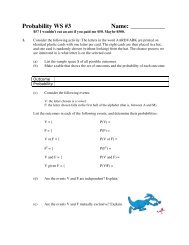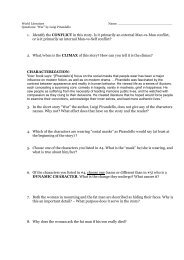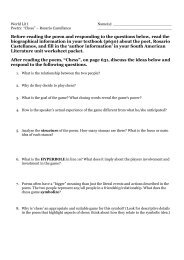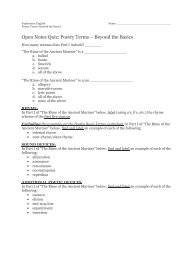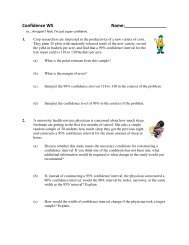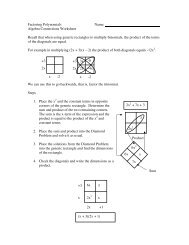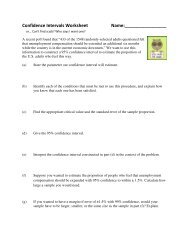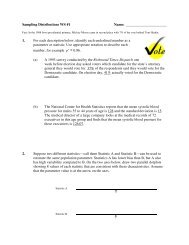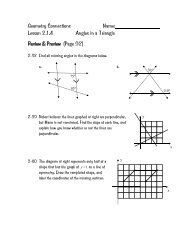Precalculus Skill Builders Vol 1 Solutions
Precalculus Skill Builders Vol 1 Solutions
Precalculus Skill Builders Vol 1 Solutions
Create successful ePaper yourself
Turn your PDF publications into a flip-book with our unique Google optimized e-Paper software.
<strong>Skill</strong> <strong>Builders</strong><br />
(Extra Practice)<br />
<strong>Vol</strong>ume I<br />
1. Factoring Out Monomial Terms<br />
2. Laws of Exponents<br />
3. Function Notation<br />
4. Properties of Lines<br />
5. Multiplying Binomials<br />
6. Special Triangles<br />
7. Simplifying and Combining Radicals<br />
8. Similar Triangles<br />
9. Factoring Standard Forms<br />
10. Inverses<br />
11. Algebraic Fractions<br />
12. Solving Quadratics<br />
13. Inequalities
1. Factoring Out Monomial Terms<br />
Example: The first thing you should look for when factoring expressions is common factors<br />
that appear in every term. These common factors could be numbers or variables,<br />
so look for common numerical factors and common variables that appear in every<br />
term.<br />
3x 2 y 5 ! 5y 3 = 3xy 3 (xy 2 ! 2)<br />
Factor out the largest single term possible from the following expressions.<br />
1. 2x 3 y + 7xy 2<br />
[ xy(2x 2 + 7y) ]<br />
3. 24!r 4 h " 20!r 2 h 4<br />
[ 4! r 2 h(6r 2 " 5h 3 ) ]<br />
5. 36x 5 y 5 z 6 ! 27x 3 y 3 z 10 + 18x 6 y 2 z 7<br />
[ 9x 3 y 2 z 6 (4x 2 y 3 ! 3yz 4 + 2x 3 z) ]<br />
7. 27 p 6 q + 45 p 5 q 2 ! 54 p 8 q<br />
[ 9p 5 q(3p + 5q ! 6p 3 ) ]<br />
9. 21x 4 y 3 + 35x 2 y 8<br />
[ 7x 2 y 3 (3x 2 + 5y 5 ) ]<br />
11. 24!r 2 h 2 + 18!r 2 h + 54!r 2<br />
[ 6! r 2 (4h 2 + 3h + 9) ]<br />
13. 2a 5 b 5 c ! 6a 3 b 3 c 6 + 7a 2 b 6 c 3<br />
[ a 2 b 3 c(2a 3 b 2 ! 6ac 5 + 7b 3 c 2 ) ]<br />
15. 8u 3 v ! 32uv 4 + 80uv<br />
[ 8uv(u 2 ! 4v 3 + 10) ]<br />
2. 42a 3 b 3 + 24a 2 b 5<br />
[ 6a 2 b 3 (7a + 4b 2 ) ]<br />
4. 30b 11 c 6 d 4 + 15b 11 c 7 d 3 ! 35b 10 c 7 d 4<br />
[ 5b 10 c 6 d 3 (6bd + 3bc ! 7cd) ]<br />
6. 6a 4 b 2 ! 7ab 4 + 7a 2 b 2<br />
[ ab 2 (6a 3 ! 7b 2 + 7a) ]<br />
8. 8 j 10 k 2 + 20 j 3 k 4<br />
[ 4 j 3 k 2 (2 j 7 + 5k 2 ) ]<br />
10. 42d 3 h 3 + 63d 2 h 5<br />
[ 21d 2 h 3 (2d + 3h 2 ) ]<br />
12. 15mn 4 ! 33m 3 n<br />
[ 3mn(5n 3 ! 11m 2 ) ]<br />
14. 15s 2 t 5 ! 25st 7 + 55st 5<br />
[ 5st 5 (3s ! 5t 2 + 11) ]<br />
16. 6x 4 y 3 + 8x 2 y 5 ! 2x 3 y 2 + 6x 2 y 2<br />
[ 2x 2 y 2 (3x 2 y + 4y 3 ! x + 3) ]<br />
Pre-Calculus with Trigonometry
2. Laws of Exponents<br />
Example:<br />
Solution:<br />
Simplify using the laws of exponents.<br />
"<br />
#<br />
$<br />
2x !3 y 2<br />
xy 3<br />
!4<br />
%<br />
&<br />
' = 2 !4 (x !3!1 ) !4 (y 2!3 ) !4 = 2 !4 x 16 y 4 = x16 y 4<br />
16<br />
Simplify the following expressions.<br />
1. (x 3 )(x 4 )<br />
[ x 7 ]<br />
2. (y 2 )(y 3 )<br />
[ y 5 ]<br />
3.<br />
a 9<br />
a 6<br />
[ a 3 ]<br />
4.<br />
p 7<br />
p 2<br />
[ p 5 ]<br />
5. (x 3 ) 3<br />
[ x 9 ]<br />
7. !<br />
"(z 2 ) 3<br />
[ z 12 ]<br />
#<br />
$<br />
2<br />
9. !<br />
"(z 2 )(x 4 )#<br />
$<br />
[ z 6 x 12 ]<br />
3<br />
6. (y 2 ) 5<br />
[ y 10 ]<br />
8. !<br />
"(b 3 ) 3 #<br />
$<br />
[ b 27 ]<br />
3<br />
10. "<br />
#(y !2 )(y 3 ) $<br />
%<br />
[ 1 ]<br />
0<br />
11. "<br />
#(a !3 )(a 5 ) $<br />
%<br />
[ a 6 ]<br />
3<br />
12.<br />
x<br />
( 4 x ) 2<br />
[ x 6 ]<br />
13. (x !3 )(x 3 ) + (y 4 )(y !4 )<br />
[ 2 ]<br />
14. (2x) 3 (3x) 2<br />
[ 72x 5 ]<br />
15.<br />
(5x) 2 (2x) 2<br />
5x<br />
[ 20x 3 ]<br />
16.<br />
! (3x) 3 (2x) 2<br />
4 x<br />
"#<br />
[ 729x 8 ]<br />
2<br />
$<br />
%&<br />
<strong>Skill</strong> <strong>Builders</strong>
3. Function Notation<br />
Example:<br />
Let f (x) = 2x 2 ! 2x + 3 and g(x) = 3x ! 5 . Find the indicated values.<br />
<strong>Solutions</strong>: a. f (!2) = 2(!2) 2 ! 2(!2) + 3 = 15<br />
b. f (x + h) = 2(x + h) 2 ! 2(x + h) + 3<br />
= 2(x 2 + 2xh + h 2 ! 2(x + h) + 3<br />
= 2x 2 + 4xh + 2h 2 ! 2x ! 2h + 3<br />
c. g( f (x)) = g(2x 2 ! 2x + 3) = 3(2x 2 ! 2x + 3) ! 5<br />
= 6x 2 ! 6x + 4<br />
Find the indicated values.<br />
1. Given f (x) = 3x 2 + 5, find f (4). [ 53 ]<br />
2. Given f (x) = 5x 3 + 3x 2 , find f (!3). [ –108 ]<br />
3. Given f (x) = 5x 2 + 3x, find f (x + h). [ 5x 2 + 10xh + 5h 2 + 3x + 3h ]<br />
4. Given f (x) = 21x 2 ! 20x, find f (x + h). [ 21x 2 + 42xh + 21h 2 ! 20x ! 20h ]<br />
5. Given f (x) = 3x 2 + 5x and g(x) = 7x + 3, find f (x)g(x). [ 21x 3 + 44x 2 + 15x ]<br />
6. Given f (x) = 6x 3 + 7 and g(x) = e x , find f (x)g(x). [ 6x 3 e x + 7e x ]<br />
7. Given f (x) = 3x 2 + 4x + 5 and g(x) = x 2 + x + 1, find f (x)g(x) if x = 3. [ 572 ]<br />
8. Given f (x) = 2x 2 + 5x and g(x) = 3x, find f (g(x)). [ 18x 2 + 15x ]<br />
9. Given f (x) = 2x 2 + 5x and g(x) = 3x, find g( f (x)). [ 6x 2 + 15x ]<br />
10. Given g(x) = 5x 2 + 5x + 5 and h(x) = 4x + 4, find g(h(x)). [ 80x 2 + 180x + 105 ]<br />
11. Given g(x) = 5x 2 + 5x + 5 and h(x) = 4x + 4, find h(g(x)). [ 20x 2 + 20x + 24 ]<br />
12. Given h(x) = 16 ! 3 5x , find h(2). [ 944784 ]<br />
13. Given f (x) = 5 ! 2 3x , find f (3). [ 2560 ]<br />
14. Given f (x) = e x !and! g(x) = 3x 2 + 2x + 6, find f (g(x)). [ e (3x2 + 2x+ 6)<br />
]<br />
15. Given f (x) = e x and g(x) = 3x 2 + 2x + 6, find g( f (x)). [ 3e 2x + 2e x + 6 ]<br />
Pre-Calculus with Trigonometry
4. Properties of Lines<br />
Given the points A = (!2, 5) and B = (3, !4) .<br />
Example 1:<br />
Find the equation of the line that goes through A and B. Write your answer<br />
in slope-intercept form.<br />
Solution: slope = (5!(!4))<br />
(!2!3)<br />
= 9 !5 = ! 9 5<br />
Now use the form y = mx + b with m = ! 9 5 to get the equation y = ! 9 5 x + b .<br />
Substitute the x and y from point A or point B and solve for b.<br />
5 = ! 9 5 (!2) + b<br />
5 = 18 5 + b<br />
b = 7 5<br />
y = ! 9 5 x + 7 5<br />
Example 2:<br />
Solution:<br />
Find the equation of the line that is perpendicular to line AB and<br />
passes through the point (2, 3).<br />
Perpendicular lines have negative reciprocal slopes. Since the slope<br />
of AB is ! 9 5 , the slope of the line perpendicular to it is 5 9 . Point-<br />
slope equations have the form y ! y 1 = m(x ! x 1 ) . Substitute (2, 3) for<br />
(x 1 , y 1 ) and 5 9 for m to get: y ! 3 = 5 (x ! 2).<br />
9<br />
Example 3: Find the distance between points A and B.<br />
Solution:<br />
( ) 2 + 5 ! (!4<br />
)<br />
d = !2 ! 3<br />
( ) 2 = !5<br />
( ) 2 + ( 9) 2 = 106<br />
<strong>Skill</strong> <strong>Builders</strong>
1. Find the equation of the line that is parallel to the line y = 3x + 9 and passes through the<br />
point (–4, 3). Write your answer in point-slope form. [ y ! 3 = 3(x + 4) ]<br />
2. Find the equation of the line that is parallel to the line y = 2x + 8 and passes through the<br />
point (–4, 3). Write your answer in slope-intercept form. [ y = 2x + 11 ]<br />
3. Find the equation of the line that is parallel to the line y = !6x ! 8 and passes through the<br />
point (8, 3). Write your answer in point-slope form. [ y ! 3 = !6(x ! 8) ]<br />
4. Find the equation of the line that is parallel to the line y = !5x ! 9 and passes through the<br />
point (7, 1). Write your answer in slope-intercept form. [ y = !5x + 36 ]<br />
5. Find the equation of the line that contains the points (1, 7) and (–5, –3). Write your answer<br />
in slope-intercept form. [ y = 5 3 x + 16 3 ]<br />
6. Find the equation of the line that contains the points (–5, –10) and (9, 6). Write your<br />
answer in slope-intercept form. [ y = 8 7 x ! 30 7 ]<br />
7. Find the equation of the line that contains the points (–1, 4) and (–5, –4). Write your<br />
answer in point-slope form. [ y ! 4 = 2(x + 1) or y + 4 = 2(x + 5) ]<br />
8. Find the equation of the line that contains the points (5, 2) and (8, 11). Write your answer<br />
in point-slope form. [ y ! 2 = 3(x ! 5) or y ! 11 = 3(x ! 8) ]<br />
9. Find the equation of the line that is perpendicular to the line y = 7x + 1 and passes through<br />
the point (3, –1). Write your answer in point-slope form. [ y + 1 = ! 1 7 (x ! 3) ]<br />
10. Find the equation of the line that is perpendicular to the line y = 6x + 2 and passes through<br />
the point (3, 7). Write your answer in slope-intercept form. [ y = ! 1 6 x + 15 2 ]<br />
11. Find the equation of the line that is perpendicular to the line y = !9x ! 8 and passes<br />
through the point (1,6). Write your answer in slope-intercept form. [ y = 1 9 x + 53<br />
9 ]<br />
12. Find the equation of the line that is perpendicular to the line y = 2x + 5 and passes through<br />
the point (–6, –7). Write your answer in slope-intercept form. [ y = ! 1 2 x ! 10 ]<br />
13. Find the distance between the points (–3, –5) and (5, 4). [ 145 ]<br />
14. Find the distance between the points (–1, 6) and (3, –4). [ 2 29 ]<br />
15. Find the distance between the points (4, 3) and (18, 14). [ 317 ]<br />
16. Find the distance between the points (0, 7) and (4, 16). [ 97 ]<br />
Pre-Calculus with Trigonometry
5. Multiplying Binomials<br />
Example:<br />
Multiply (x + 2)(x ! 5) . Each term in the first binomial is distributed over the<br />
second binomial, as shown below.<br />
Solution: (x + 2)(x ! 5) = x(x ! 5) + 2(x ! 5) = x 2 ! 5x + 2x ! 10 = x 2 ! 3x ! 10<br />
Multiply the following binomials.<br />
1. (x + 3)(x ! 6)<br />
[ x 2 ! 3x ! 18 ]<br />
3. (b 2 – 3)(b + 5)<br />
[ b 3 + 5b 2 – 3b – 15 ]<br />
5. (p 11 – p 10 )(p 10 – p 9 )<br />
[ p 21 – 2p 20 + p 19 ]<br />
7. (5h 4 + 1)(6h – 2)<br />
[ 30h 5 – 10h 4 + 6h – 2 ]<br />
9. (x + 3)(x + 6)(x – 7)<br />
[ x 3 + 2x 2 – 45x – 126 ]<br />
11. (m 99 + m 98 )(m 97 – m 96 )<br />
[ m 196 – m 194 ]<br />
13. (100 j 100 – j)(9 j 2 + 1)<br />
{ } ]<br />
[ 900 j 102 + 100 j 100 – 9 j 3 – j<br />
15. (c 2 x + d 3 y)(2x + c 2 d)<br />
[ 2c 2 x 2 + 2d 3 xy + c 4 dx + c 2 d 4 y ]<br />
2. (a 3 + 1)(a 2 – 4)<br />
[ a 5 – 4a 3 + a 2 – 4 ]<br />
4. (z 3 + 1)(z 2 – 1)<br />
[ z 5 – z 3 + z 2 – 1 ]<br />
6. (q 4 + 4)(q 3 + 3)<br />
[ q 7 + 3q 4 + 4q 3 + 12 ]<br />
8. (d 5 – d 4 )(d 6 + 1)<br />
[ d 11 – d 10 + d 5 – d 4 ]<br />
10. (x 2 + 3)(x – 2)(x + 1)<br />
[ x 4 – x 3 + x 2 – 3x – 6 ]<br />
12. (6n 4 + 3n 3 )(6n 3 + 3n 2 )<br />
[ 36n 7 + 36n 6 + 9n 5 ]<br />
14. (2!k 5 + 5k 4 )(!k + 3)<br />
[ 2! 2 k 6 + 11! k 5 + 15k 4 ]<br />
16. ( f 3 y 3 + g 2 x 2 )( fy + gx)<br />
[ f 4 y 4 + f 3 gxy 3 + fg 2 x 2 y + g 3 x 3 ]<br />
<strong>Skill</strong> <strong>Builders</strong>
6. Special Triangles<br />
Example: The following relationships exist between the sides of the special triangles.<br />
Use these relationships to solve each of the following problems.<br />
1. Solve for angles α and β in the triangle at<br />
right. [ ! = 30 ! , " = 60 ! ]<br />
2. Given a 30-60-90 triangle with hypotenuse length 8, find the exact length of the long leg.<br />
[ 4 3 ]<br />
3. A 30-60-90 triangle has a hypotenuse 0.5 inches long. How long is the short leg?<br />
[ 0.25 inches ]<br />
4. Given a 30-60-90 triangle whose long leg is 13 cm, how long is the hypotenuse? (Solve<br />
exactly.) [ 26 3<br />
3<br />
cm ]<br />
5. Solve for leg lengths a and b.<br />
[ Both a and b = 5 . ]<br />
6. Given a 45-45-90 triangle with hypotenuse length 13 2 , how long are the legs?<br />
[ 13 each ]<br />
7. If a 45-45-90 triangle’s legs are 17 mm long, exactly how long is its hypotenuse?<br />
[17 2 mm ]<br />
8. What is the exact area of the equilateral triangle whose legs are each 6 cm long?<br />
[ 9 3 cm 2 ]<br />
Pre-Calculus with Trigonometry
9. Find the exact area of the following isosceles<br />
triangle.<br />
[ 25 3<br />
4<br />
units 2 ]<br />
5<br />
30˚<br />
5<br />
10. A triangle has angles 30˚, 60˚, and 90˚, and its legs have lengths 7 3 , 7, and 14. How long<br />
is the side opposite the 60˚ angle? [ 7 3 ]<br />
11. Solve for α and β in the following triangle.<br />
[ ! = 30 ! , " = 60 ! ]<br />
12. If a 30-60-90 triangle has a hypotenuse length 100, how long is the short leg? [ 50 ]<br />
13. A 30-60-90 triangle with long leg length 15 3 has a hypotenuse of what length? [ 30 ]<br />
14. Find the area of the triangle at right.<br />
[ 100 3 ]<br />
20<br />
20<br />
30˚<br />
15. Solve for length x in terms of c.<br />
[ x = c 2 ]<br />
16. Solve for lengths x and y in terms of b.<br />
[ x = b 3, y = 2b ]<br />
<strong>Skill</strong> <strong>Builders</strong>
7. Simplifying and Combining Radicals<br />
Example: Simplify 288 .<br />
When you are asked to write a radical in simpler form, the real task is to reduce the number<br />
under the radical sign as much as possible by taking perfect squares outside the radical.<br />
Solution: Simplify 288 . Find the factorization of 288, choosing perfect<br />
squares as factors whenever possible.<br />
288 = 4 ! 4 ! 9 ! 2<br />
288 = 4 4 9 2<br />
288 = 2 ! 2 ! 3! 2<br />
288 = 12 2<br />
Rewrite the following as radicals in simpler form.<br />
1. 1200 [ 20 3 ] 2. 845 [ 13 5 ]<br />
3. a 3 b 5 [ ab 2 ab ] 4. x 7 b 9 [ x 3 b 4 xb ]<br />
Example: Simplify 3 125 ! 2 80 .<br />
Solution:<br />
First simplify each radical separately and then combine like terms.<br />
3 125 = 3 25 5 = 15 5<br />
2 80 = 2 16 5 = 8 5<br />
3 125 ! 2 80 = 15 5 ! 8 5 = 7 5<br />
Simplify the following expressions.<br />
5. 5 + 18 [ 5 + 3 2 ] 6. 54 + 294 [ 10 6 ]<br />
7. 18 + 108 + 50 + 48<br />
[ 8 2 + 10 3 ]<br />
8. ( 99 ) 2 [ 99 ]<br />
9. ( 12)( 75) [ 30 ] 10. ( 20)( 80) [ 40 ]<br />
11. ( 50)( 98) [ 70 ]<br />
Pre-Calculus with Trigonometry
Example: Rationalize<br />
45 .<br />
Solution:<br />
To rationalize the denominator you need to multiply both numerator and<br />
denominator by the radical in the denominator. This is equivalent to<br />
multiplying by 1 so it does not change the value of the expression.<br />
4<br />
5 = 4 5<br />
5<br />
= 4 5<br />
5 5<br />
Rationalize the following expressions.<br />
12.<br />
3<br />
2<br />
[ 3 2<br />
2<br />
] 13.<br />
5<br />
7<br />
[ 5 7<br />
7<br />
] 14.<br />
a 2 b 4<br />
a 5 b 9<br />
[ ab<br />
ab ]<br />
Example: Combine and simplify 2 3 + 1<br />
2 3 .<br />
Solution:<br />
To combine rational expressions you first need to find a common denominator<br />
and write the expression as one fraction. Then, you must rationalize the<br />
denominator.<br />
23 + 1 = 2!2 + 1 = 5 = 5 3<br />
2 3 2 3 2 3 2 3 6<br />
Rewrite the following as single, rationalized expression.<br />
15.<br />
3<br />
2 + 6 2<br />
[ 9 2<br />
2<br />
] 16.<br />
6<br />
8 + 3 8<br />
[ 9 2<br />
4<br />
]<br />
<strong>Skill</strong> <strong>Builders</strong>
8. Similar Triangles<br />
Example:<br />
Solution:<br />
Find the length of x.<br />
To find x you need to put corresponding<br />
sides in a ratio. In this triangle 17<br />
corresponds to 7 and 12 corresponds to x.<br />
So our ratio is: x<br />
12 = 7<br />
17<br />
17x = 84<br />
x = 4.941<br />
Solve each triangle for the indicated variable.<br />
1. Find the length of x.<br />
[ x = 48 9 ]<br />
2. Find the length of y.<br />
[ x = 16.5 ]<br />
3. Find the length of x.<br />
[ x = 11.2 ]<br />
4. Find the length of x.<br />
[ x = 128<br />
21 ]<br />
Pre-Calculus with Trigonometry
5. Find the length of x.<br />
[ x = 21<br />
5 ]<br />
6. Find the length of x.<br />
[ x = 22 3 ]<br />
7. Find the length of k in terms of x.<br />
[ k = 2x ]<br />
8. Find the value of h in terms of y.<br />
[ h = 4 y ]<br />
10! y<br />
9. Find the length of b in terms of x.<br />
[ b = x 2 ]<br />
10. Find the value of h in terms of x.<br />
[ h = 13x<br />
x + 5 ]<br />
<strong>Skill</strong> <strong>Builders</strong>
11. Kathleen is 6 feet tall. Her shadow is 3 feet long. At the same time of day, a tree casts a<br />
shadow that is 21 feet long. How tall is the tree? [ 42 feet ]<br />
12. Kyle is 1.5 meters tall and casts a shadow 4 meters long. A flagpole casts a shadow that is<br />
30 meters long. How tall is the flagpole? [ 11.25 meters ]<br />
13. Lisa’s dog is 2.5 feet tall and casts a shadow that is 4 feet long. A fire hydrant casts a<br />
shadow that is 6 feet long. How tall is the fire hydrant? [ 3.75 feet ]<br />
14. Fernando is constructing a scale model of his father’s yacht. The actual yacht has a sail<br />
that is 25 feet tall and the base of the sail is 15 feet long. If the model’s sail is 14 inches<br />
tall, how long is its base? [ 8.4 inches ]<br />
15. Cameron is building a scale model of his sailboat. The right-triangular sail of the actual<br />
boat has a base that is 12 feet long. The height of the actual sail is 20 feet long. The base<br />
of the model’s sail is 8 inches long. How long is the hypotenuse of the model’s sail? (The<br />
hypotenuse is different from the height!) [ 8 34<br />
3<br />
]<br />
16. List all of the similar triangles that are in the<br />
figure at right. [ ∆ABC, ∆APB, ∆CPB ]<br />
Pre-Calculus with Trigonometry
9. Factoring Standard Forms<br />
Rules for Factoring<br />
Difference of Two Squares: a 2 ! b 2 = (a + b)(a ! b)<br />
Sum of Two Cubes: a 3 + b 3 = (a + b)(a 2 ! ab + b 2 )<br />
Difference of Two Cubes: a 3 ! b 3 = (a ! b)(a 2 + ab + b 2 )<br />
Special Products<br />
(a + b) 2 = a 2 + 2ab + b 2<br />
(a ! b) 2 = a 2 ! 2ab + b 2<br />
(a + b) 3 = a 3 + 3a 2 b + 3ab 2 + b 3<br />
(a ! b) 3 = a 3 ! 3a 2 b + 3ab 2 ! b 3<br />
Factor each of the following expressions.<br />
1. x 2 ! 12x + 36<br />
[ (x ! 6) 2 ]<br />
3. 9a 2 + 24a + 16<br />
[ (3a + 4) 2 ]<br />
5. (x + y) 2 ! 4(x + y) + 4<br />
[ (x + y ! 2) 2 ]<br />
7. b 2 ! 16<br />
[ (b ! 4)(b + 4) ]<br />
9. 4x 2 ! 1<br />
[ (2x ! 1)(2x + 1) ]<br />
11. s 6 ! t 6<br />
[ (s 3 ! t 3 )(s 3 + t 3 ) ]<br />
13. a 3 ! b 3<br />
[ (a ! b)(a 2 + ab + b 2 ) ]<br />
2. z 2 ! 6z + 9<br />
[ (z ! 3) 2 ]<br />
4. 16x 2 + 40xy + 25y 2<br />
[ (4x + 5y) 2 ]<br />
6. 4(a ! b) 2 ! 8(a ! b) + 4<br />
[ 4(a ! b ! 1) 2 ]<br />
8. 7x 4 ! 7<br />
[ 7 x + 1 ( ) (x ! 1)(x 2 + 1) ]<br />
10. (a ! b) 2 ! (a + b) 2<br />
[ !4ab ]<br />
12. x 3 + 1<br />
[ (x + 1)(x 2 ! x + 1) ]<br />
14. 8 p 3 + 27q 3<br />
[ (2p + 3q)(4p 2 ! 6pq + 9q 2 ) ]<br />
<strong>Skill</strong> <strong>Builders</strong>
10. Inverses<br />
Example: Find the inverse of f (x) = x!2<br />
x<br />
Solution: y = x!2<br />
x<br />
Start by replacing f(x) with y.<br />
x = y!2<br />
2<br />
xy = y ! 2 Solve for y.<br />
xy ! y = 2<br />
y(x ! 1) = 2<br />
y = 2<br />
x!1<br />
Interchange x and y in the equation.<br />
f 1 (x) = 2<br />
x!1 Replace y with f !1 (x) .<br />
Find the equation of the inverse for each function below.<br />
1. f (x) = 3x + 1<br />
[ f !1 (x) = x!1<br />
3<br />
]<br />
3. f (x) = x 2 + 5<br />
[ f !1 (x) = ± x ! 5 ]<br />
5. f (x) = x!4<br />
5<br />
[ f !1 (x) = 5x + 4 ]<br />
7. f (x) = 3 4 x + 8<br />
[ f !1 (x) = 4 3 (x ! 8) ]<br />
9. f (x) = 3 x<br />
[ f -1 (x) = log 3 x ]<br />
2. f (x) = 5 ! 6x<br />
[ f !1 (x) = 5– x<br />
6<br />
]<br />
4. f (x) = 4x 2<br />
[ f !1 (x) = ± x<br />
2<br />
]<br />
6. f (x) = x+10<br />
11<br />
[ f !1 (x) = 11x ! 10 ]<br />
8. f (x) = 7 ! x 2<br />
[ f !1 (x) = 7 – x ]<br />
10. f(x) = log x<br />
[ f -1 (x) = 10 x ]<br />
11. f (x) = x+3<br />
12. f (x) = x!4<br />
x<br />
x<br />
[ f !1 (x) = x!1 3 ] [ f !1 (x) = 4<br />
13. f (x) = 11x!12x2<br />
x<br />
[ f !1 (x) = 11– x<br />
12<br />
]<br />
1! x ]<br />
14. f (x) = 3x+4<br />
5x<br />
[ f !1 (x) = 4<br />
5x! 3 ]<br />
15. f (x) = 10x!15x2<br />
16. f (x) = 7x!4<br />
5x 2<br />
3x<br />
[ f !1 (x) = x+ 2 ] [ f !1 (x) = !4<br />
3<br />
3x –7 ]<br />
Pre-Calculus with Trigonometry
11. Algebraic Fractions<br />
Facts about Fractions<br />
PK<br />
QK = P Q<br />
where Q ! 0 and K ! 0<br />
Multiplication:<br />
P<br />
Q ! R S = PR<br />
QS<br />
Division:<br />
P<br />
Q ÷ R S = P Q ! S R = PS<br />
QR<br />
Addition:<br />
Subtraction:<br />
P<br />
Q + R Q = P+R<br />
Q<br />
P<br />
Q ! R Q = P!R<br />
Q<br />
Simplify the following fractions.<br />
1.<br />
1 a<br />
b [ 1 ab ] 2.<br />
1 a<br />
1 b [ b a ]<br />
3.<br />
x 2 –9<br />
x–3 [ x + 3 ] 4. x 2 –5x–6<br />
x 2 –1<br />
5.<br />
x 2 –25<br />
5– x<br />
[ !(x + 5) ] 6.<br />
[ x ! 6<br />
x !1 ]<br />
a 3 +b 3<br />
a 2 –b 2 [ a2 ! ab+ b 2<br />
a! b<br />
]<br />
Example:<br />
Solution:<br />
Use Fraction Busters to solve<br />
x<br />
3 + 5 x = 2 .<br />
Multiply every term on both sides of the<br />
equation by all the terms in the<br />
denominator.<br />
Now you have an equation without<br />
fractions.<br />
Use the Quadratic Formula to solve.<br />
3! x ! x 3 + 3! x ! 5 x = 2 ! 3! x<br />
/3! x ! x /3 + 3! /x ! 5 /x = 6x<br />
x 2 + 15 = 6x<br />
x 2 " 6x + 15 = 0<br />
x=3±i 6<br />
<strong>Skill</strong> <strong>Builders</strong>
Use Fraction Busters to solve for x.<br />
7.<br />
1<br />
x + 3<br />
x 2 = 4 [ x = 1, ! 4 3 x<br />
] 8.<br />
3 ! x+1<br />
5 = 2x + 1 5 [ ! 14 3 ]<br />
x<br />
9.<br />
3 + 1 2 = x+2<br />
6 ! 2 3 [ x = !5 ] 10. 2<br />
3x + x+2 = 5x + 1 5 3 [ 1± 2881<br />
x = ]<br />
144<br />
Simplify the following expressions.<br />
11. 1 + 1<br />
1+ 1<br />
1+1<br />
[ 5 3 ] 12.<br />
1! 1 y<br />
1<br />
y<br />
[ y!1<br />
y<br />
]<br />
13.<br />
1 ! 2 x<br />
1 ! 3 x<br />
[ x ! 2<br />
x! 3 ]<br />
14.<br />
1<br />
a + 2 b<br />
2<br />
a + 1 b<br />
[ 2a+ b<br />
2b+ a ]<br />
15.<br />
x!1<br />
x+1 ! x+1<br />
x!1<br />
x!1<br />
x+1 + x+1<br />
x!1<br />
[ !2x<br />
1+ x 2 ] 16.<br />
a+b<br />
2a 2<br />
a!b<br />
4a<br />
[<br />
2(a+ b)<br />
] a(a! b)<br />
Pre-Calculus with Trigonometry
12. Solving Quadratics<br />
Solve the quadratic equations.<br />
Example 1: 4x 2 ! 12x = 0<br />
Solution: This type of problem is easily factored into 4x(x ! 3) = 0 .<br />
Now you can get the solutions 4x = 0 or x ! 3 = 0 , x = 0 or x ! 3 = 0 .<br />
Example 2: x 2 ! 2x + 13 = 0<br />
Solution: This equation cannot be factored so you should use the Quadratic Formula.<br />
x =<br />
2± !48<br />
2<br />
= 2±4i 3<br />
2<br />
= 1 ± 2i<br />
Example 3: x + 1 = x + 2<br />
Solution: When there are square roots in the problem you will need to square both sides.<br />
( x + 2) 2 = ( x + 1) 2<br />
x + 2 = x + 2 x + 1<br />
1<br />
=<br />
2<br />
x Since there is still a square root, move all<br />
the other terms away from the root.<br />
1<br />
= x Now square both sides.<br />
4<br />
0.25 + 2 = 0.25 + 1 Make sure you plug the answer back into<br />
the original equation because sometimes<br />
extra solutions appear when you square<br />
equations.<br />
1.5 = 1.5<br />
<strong>Skill</strong> <strong>Builders</strong>
Solve for the indicated variable.<br />
1. 9x 2 ! 12x = 0<br />
[ x = 0, 4 3 ]<br />
3. 1 ! 1 x = 12<br />
x 2<br />
[ x = !3, 4 ]<br />
5. (y + 6)(y ! 2) = !7<br />
[ y = !5, 1 ]<br />
7. (y ! 5) 2 = 9<br />
[ y = 2, 8 ]<br />
9. x 4 ! x 2 = 20<br />
[ x = ± 5 ]<br />
11. x + 5 = x + 1<br />
[ x = 4 ]<br />
13. x 2 + 5x + 11 = 0<br />
[ x =<br />
!5± i 19<br />
2<br />
]<br />
15. x 2 ! x + 3 = 0<br />
[ x =<br />
1± i 11<br />
2<br />
]<br />
2. 2r + 1 = 15r 2<br />
[ r = ! 1 5 , 1 3 ]<br />
4. x ! 4 3x = ! 1 3<br />
[ x = 1, ! 4 3 ]<br />
6. x + 2 = x ! 4<br />
[ x = 7 ]<br />
8. (y + 3) 2 = 18<br />
[ y = !3 ± 3 2 ]<br />
10. x 4 + 20 = 9x 2<br />
[ x = !2, 2, ± 5 ]<br />
12. x + 4 = 2 ! 2x<br />
[ x = 0 ]<br />
14. x 2 + 1 = 0<br />
[ x = ±i ]<br />
16. x 2 = !(5 + x)<br />
[ x =<br />
!1± i 19<br />
2<br />
]<br />
Pre-Calculus with Trigonometry
13. Inequalities<br />
Example 1: Solve: 3x ! 5 " 13.<br />
Solution: Start by writing the inequality. !13 " 3x ! 5 " 13<br />
Add 5 to all three members. !8 " 3x " 18<br />
Divide all three members by 3. ! 8 3 " x " 6<br />
The answer written in interval notation is "<br />
#! 8 3 , 6 $<br />
% .<br />
Remember that if you multiply or divide an inequality by a negative number<br />
you must reverse the inequality. For example, solve !2x " 18 , x ! "9 .<br />
Dividing both sides by –2 reverses the inequality.<br />
Example 2: Solve: x 2 ! x > 6<br />
Solution: As with equations, we need to have a polynomial equal to zero so that we can<br />
factor.<br />
Subtract 6 from both sides. x 2 ! x ! 6 > 0<br />
Factor: (x ! 3)(x + 2) > 0<br />
Find the zero’s. x = 3, x = !2<br />
Test the intervals to find where the quadratic is greater than zero.<br />
+++ - - - - - - ++++<br />
< ><br />
-2 3<br />
Here the interval is positive for values less than –2 or greater than 3. It is negative<br />
between –2 and 3.<br />
Express the solution using inequalities x < !2 or x > 3 .<br />
<strong>Skill</strong> <strong>Builders</strong>
Solve the inequality. Write your answer in either interval or inequality notation.<br />
1. x ! "2 [ all real numbers ] 2. x ! 3 < 7 [ !4 < x < 10 ]<br />
3. x ! 3 + 2 < 6 [ !1 < x < 7 ] 4. 2x + 1 + 4 ! 7 [ x ! "2 and x # 1 ]<br />
5. x 2 + x ! 6 > 0 [ x < !3, x > 2 ] 6. x 2 ! x ! 12 " 0 [ !3 " x " 4 ]<br />
7. 6x 2 < 5x ! 1 [ 1 3 < x < 1 2 ] 8. (x ! 2)(x ! 3)(x ! 4) > 0<br />
[ 2 < x < 3, x > 4 ]<br />
Solve the inequality and graph the solution set.<br />
9. x ! 1 < !3 [ no solution ] 10. 3x + 9 ! 6 [ x ! "5 and x # "1 ]<br />
Example: Graph the solution y + 5 > 2x .<br />
y<br />
Solution:<br />
Begin by treating the expression as an equality<br />
and sketch the graph. So begin by graphing<br />
y = 2x ! 5 . Since the inequality is y greater<br />
than 2x ! 5 the line is dotted because it is not<br />
included. Next you should choose a test point<br />
on one side of the line and plug it into the<br />
inequality. If it makes the inequality true, then<br />
shade that side of the graph. If it makes the<br />
inequality false, than shade the other side of the<br />
graph. A good point to use (as long as it is not<br />
on the graph) is (0, 0). If we substitute x = 0<br />
and y = 0 into the inequality, then it becomes<br />
0 + 5 > 10 , which is false so shade the other<br />
side of the line.<br />
–5<br />
5<br />
–5<br />
5<br />
x<br />
Pre-Calculus with Trigonometry
Graph the solution.<br />
11. x ! 2y < 4 12. x 2 + 5x ! "6<br />
y<br />
x<br />
–4 –2 0 2 4<br />
13. 2x + 3y ! 6 14. x ! y > !3<br />
y<br />
y<br />
x<br />
x<br />
15. 2x + y ! 5 16. 3x + 5y ! 7<br />
y<br />
y<br />
x<br />
x<br />
<strong>Skill</strong> <strong>Builders</strong>



